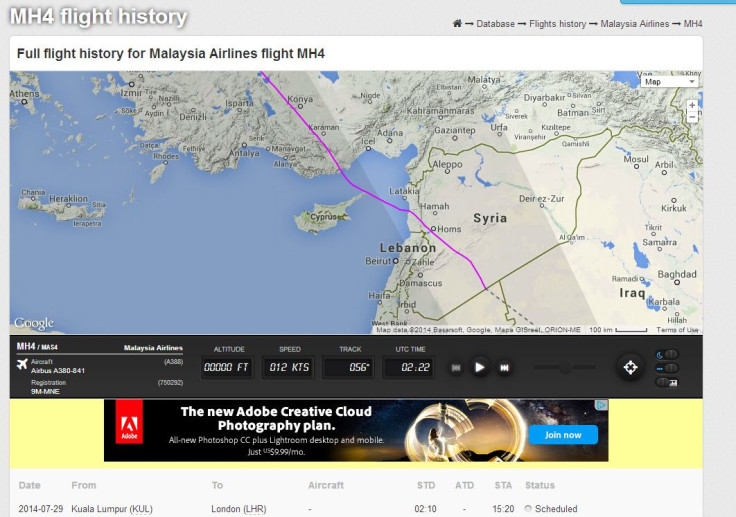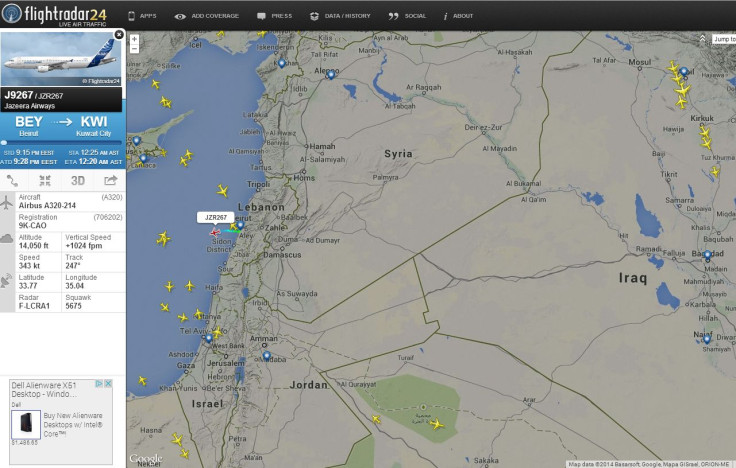After MH17 Shootdown Over Ukraine, Malaysia Airlines Sends Flight MH4 Over Syria

Malaysia Airlines has stopped flying over Ukraine, as has every other airline, after the shootdown of flight MH17 on Thursday by an anti-aircraft missile killed all 298 passengers and crew. In the aftermath of the shootdown, possibly the work of pro-Russian separatists who had managed to get their hands on a Soviet-made SA-11 (“Buk”) missile, airlines traded safety for the convenience of taking the shortest route between Europe and most major air hubs in Asia.
But the alternatives can be as dangerous as flying over the rebel-held territory of Eastern Ukraine. Malaysia Airlines found itself facing controversy related to flight routes again on Sunday, when flight MH4 from Kuala Lumpur to London flew over Syria, an active war zone.
Flight tracking site Flightradar24.com showed that the flight, operated by a 494-seat seat Airbus A380, had entered Syrian airspace from Jordan and crossed the country in a northwesterly direction exiting over the Mediterranean Sea.

Malaysia Airlines responded with a statement that said the flight was not violating any rule by taking the route it did.
“MH004’s flight plan is in accordance to International Civil Aviation Organisation’s (ICAO) approved routes. As per the notice to airmen (NOTAM) issued by the Syrian Civil Aviation Authority, the Syrian airspace was not subject to restrictions. At all times, MH004 was in airspace approved by ICAO. Malaysia Airlines maintains that safety of its passengers and crew is of utmost priority,” said the statement. On Monday, the flight took a different route, avoiding Syria as well as Ukraine.
Technically, Malaysia Airlines is right: The International Civil Aviation Organization does not bar airlines from flying over Syria. However, it has noted in a document dated March 2013 that flying over Syria can be extremely dangerous.
“Incidents have recently taken place involving civil aircraft transiting the Damascus FIR,” wrote the ICAO Secretary General, Raymond Benjamin, referring to the Damascus flight information region, a subdivision of airspace that includes all of Syria. “Such incidents include situations whereby civil aircraft unexpectedly found themselves in close proximity to munitions and missile firings,” a situation that obviously would put passengers and crews at great risk.
It should be noted that the incidents mentioned by ICAO likely did not include the firing of missiles capable of reaching high altitudes, but referred to portable shoulder-fired missiles and to anti-aircraft guns. The Syrian opposition has reportedly shot down several government aircraft, using guns and Soviet-made heat-seeking missiles. Those cannot threaten airplanes at the cruising altitude of modern jetliners, but are a significant threat to planes landing and taking off.
Aviation authorities from developed countries, including Great Britain’s Civil Aviation Authority, took their cue from ICAO and issued warnings about “serious risks” in Syria, which however did not ban airlines from flying there but merely cautioned them against it.
The strongest of those caution notices was issued in May 2013 by the U.S. Federal Aviation Authority. This special notice warned pilots that “operating in the Damascus FIR is hazardous to flight operations” and that “U.S. operators or airmen planning to fly, into out of, within or over Syria” would have to notify the FAA.
In a separate note, the FAA warned pilots that there had been several incidents of planes targeted at low altitude, and that there had even been a report of high-altitude risks: “A Russian air carrier transiting Syrian airspace reported missiles detonating near the aircraft while operating at approximately FL320” or 32,000 feet (9,700 meters), said the FAA, while noting that “the event has not been confirmed.”
The FAA also worryingly pointed out that Syrian rebels had possibly captured a very dangerous high-altitude weapon from the Syrian government’s Soviet-supplied arsenals. “In January, a video released by anti-U.S. extremists from the al-Nusrah Front shows militants who had overrun a strategic weapons storage area standing in front of two captured SA-5 missiles,” the U.S. authority said.
While near-impossible to operate for untrained rebels, the SA-5 (or S-200 as it is known in the Russian original nomenclature) is a fearsome weapon: Developed during the Cold War to hit U.S. bombers flying in the stratosphere, it can hit targets at 40,000 meters (130,000 ft) of altitude and up to 300 kilometers (190 miles) away. It was an SA-5 that mistakenly hit a Russian airliner over the Black Sea in 2001, killing all 78 aboard.
Such warnings have had an effect on airlines. Most of them are avoiding Syria.
A screenshot from flight tracking site Flightradar24.com taken at 2:30 p.m. ET on Monday, 9:30 p.m. in Syria, showed no civilian flights over the entire country. In fact flights were going out of their way to avoid the Syrian airspace. A Jazeera Airways flight from Beirut, Lebanon, to Kuwait, a route that would overfly Syria if taken directly, was headed out over the Mediterranean Sea, the opposite of where its destination was, in order to go south over Egypt and reach Kuwait by going over Saudi Arabia.

Those cautionary measures are expensive as they burn more fuel, which is the biggest single cost item for airlines. For this reason, not all carriers avoid Syria. One of those who still overfly the country is Lebanon-based Middle East Airlines, which said on its Facebook page last year that it would continue to go over Syria while continuously monitoring the situation.
Malaysia Airlines isn’t alone in assessing Syria overflights on a case by case basis. According to a Wall Street Journal report, Emirates Airline -- the biggest carrier in the Middle East -- decided to allow overflying Syria briefly in some cases. But a search on Flightradar24.com on Monday showed that every Emirates flight from Europe to Dubai (as well as every single flight going from Europe to the Gulf or South Asia) was hooking around Syria, to fly over Northern Iraq.
That is, to be sure, another conflict zone. But at least it’s one where no warring parties have, or are suspected of having, advanced anti-aircraft weapons.
© Copyright IBTimes 2024. All rights reserved.






















